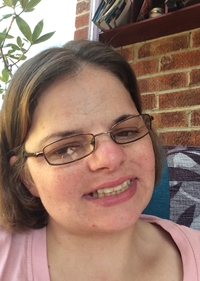Receiving a heart transplant
On a perfectly normal October morning, 18 year-old Donna Richardson set off from home as usual for the short walk to college.
Donna recalls: “I had a bad stabbing pain in my back, which I put down to indigestion but it got worse as I walked and my friends eventually called my mum to come and pick me up. When I started to get pins and needles in my arm after a sleep on the sofa, mum called the doctor’s surgery and on their advice dialled 999 for an ambulance. Two minutes after we arrived at my local hospital I had two massive heart attacks.”

Heart bypass operation
Donna was transferred to the John Radcliffe hospital in Oxford where she underwent a double heart bypass operation. Although the surgery went well, she could not be weaned off the machine that was doing the job of her heart during the operation.
The surgeons suspected that a transplant was Donna’s only option and contacted Mr Asghar Khaghani, consultant cardiothoracic surgeon and director of the Transplant Unit at Harefield. As Donna was too sick to be transferred, Mr Khaghani and a team of doctors and nurses travelled to her at the John Radcliffe.
Artificial heart
It was immediately clear that Donna’s heart was not functioning and that she needed a transplant. To support her until a donor organ became available, a further operation was performed to implant a left ventricular assist device (LVAD). This device is often used as a bridge to transplant surgery, helping the heart to function until a donor heart becomes available.
It was another fifteen days before she was well enough to be transferred to Harefield for specialist care by the transplant team. Donna was then visited by Heather Constance, one of Harefield’s three transplant coordinators, and it was only then that she realised she needed a heart transplant.
“I was pretty scared,” she remembers, “but Heather told me what was involved, and explained that although I’d have to wait until a suitable donor became available, it would help me if I was fitter and feeling better before the transplant happened. I knew that without a transplant I wouldn’t have a future”.
Support from other patients
She spent another five months at Harefield recovering. “It was really hard when another patient who was put on the waiting list after me had a transplant before me – even though I knew that it was all about having a suitable donor,” says Donna “but the staff helped me through all that.
The nurses were lovely and I could speak to the Unit’s psychologist when I felt the need. They also organised talks from previous patients who’d been through it all, and it was helpful to hear from them.”
Just as Donna was preparing for her very first home visit, a donor heart became available. The double operation – to remove the LVAD and then transplant the donor heart – took nine-and-a-half hours. Because of the extent of the surgery, Donna was expected to remain in a serious condition in ITU for a week. In fact, she was out within four days.
Up in four days
“While I was still unconscious, I was trying to pull out my breathing tubes. The staff thought this was a good sign and so brought me around! I was sitting up on the fourth day and was walking about on day five. I was at Harefield for another three weeks, recovering from the surgery and having lots of physiotherapy. I had been pretty much bed-bound for months so had to get the strength back in my muscles and learn to walk up straight again after I’d lost the weight of the LVAD machine. The physios were great – they gave me my own exercise cycle in my room, so that really helped.”
Donna now has a check-up every six months and takes anti-rejection drugs every day. “I strongly believe that that the law should be changed so that we are all potential organ donors unless we take action to opt out,” she concludes.
“Just like most people I didn’t have reason to think about it before, but the shortage of donors means that there are many patients like me who may never get the chance to live a normal life again.”
